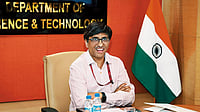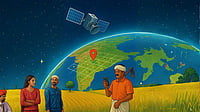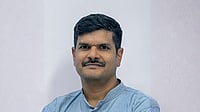The number of drone start-ups in India’s defence tech space has grown significantly in recent years. However, a large portion of the components required to assemble drones continues to be imported, particularly from China, signifying much dependence.
In contrast, ideaForge has taken a more self-reliant approach. In a conversation with Outlook Business, co-founder Ankit Mehta shared that the company has developed its own electronic boards, software and the core intelligence systems that power its drones.
When it comes to camera systems, Mehta clarified that ideaForge sources them from friendly nations not from adversarial countries.
Edited Excerpts:
With drone start-ups booming, should the focus now shift to cyber and intelligence defence—especially after Operation Sindoor?
It is difficult to have an either-or conversation because both developments happen simultaneously. There will be cyberattacks, including on drones. Cybersecurity is a key element in protecting the drone assets that the country will use for its own purposes.
At the same time, we must ensure that cybersecurity remains a critical priority. It is an important vector and we must safeguard all our digital assets accordingly. Both aspects are essential. Any improvement in cybersecurity, especially in securing edge devices, will benefit the drone industry as well.
As most Indian drone start-ups rely on imports, how is ideaForge standing out in driving indigenisation in defence tech?
To explain how ideaForge stands out, we have been building drones since 2004, when the drone industry was still very new, not just in India but globally. In fact, we developed our first autopilot around 2007, before the world’s first open-source autopilot—which led to many of today’s low-cost imports—was released in 2009.
This gives us a strong legacy of homegrown technology. In this space, we are not behind at all. We have built our own electronic boards, software and all the intelligence required for drones to function properly.
At ideaForge, we focus on building the autopilot, which is essentially the brain of the drone. It flies the drone and keeps it stable in the air.
In hobby drones, a person usually holds a remote and directly controls the aircraft. In our case, the autopilot flies the drone independently. The operator only gives instructions such as where to go or what to do and the autopilot handles flying and motor control.
To do this, the autopilot must receive information and commands. That is where the communication system comes in. It enables the drone to receive mission details from the operator on the ground.
In India, we mostly use open frequency bands (called ISM bands) that are free but heavily congested, especially in cities. We had to innovate to ensure our drones can fly long distances and operate reliably despite interference from Wi-Fi and other signals.
A strong communication link between the drone and the operator is critical. It is not just about sending commands from the ground to the drone but also about transmitting video and other data back from the drone to the ground. This enables the operator to see what the drone sees and take informed decisions.
The communication system has two parts: one on the drone and one on the ground. The ground component connects to control software that runs on a laptop, tablet or controller. We built this software in-house to ensure it is intuitive and easy to use, especially for soldiers in the field.
We have also designed our own ground controller that helps pilots operate the drone with ease.
On the drone, we work on ensuring the camera is powerful. It must offer clear visibility both during the day and at night and detect people or activities on the ground that are important to the mission.
Given the camera’s crucial role in defence drones, especially for national security, does ideaForge manufacture its own systems or rely on imports?
Security is a top priority for us, especially because drones are strategic assets for the armed forces. That is why we have always ensured that no part of the camera system, including chips or hardware, comes from adversarial countries long before government CCTV guidelines highlighted this concern.
When it comes to drone cameras, there are two key components: the camera itself, which captures the footage, and the control system—specifically the gimbal that stabilizes the camera, much like handheld gimbals used in videography. This stabilisation is crucial because it ensures the image or video is clear and usable.
While the camera sensors themselves are currently not manufactured in India, we are actively working on sourcing them domestically. Until then, we procure them only from friendly countries, never from geographies of concern. The same approach applies to microcontrollers, processors, and integrated circuits, which we source responsibly due to limited domestic manufacturing.
However, we build the entire control and stabilisation mechanism, the gimbal, onboard computing system, and image processing software in-house. This enables real-time data processing directly on the drone, allowing it to deliver actionable insights quickly.
A drone should offer long flight time and reliability, especially for soldiers in the field who rely on it during critical operations. To achieve this, we use lightweight materials, optimise power consumption and fine-tune every subsystem from the battery to motors to ensure maximum efficiency. This level of engineering ensures that our drones are not only secure and high-performing but also used effectively worldwide, outperforming many others in the same class.
Defence tech start-ups often face delays and regulatory hurdles. How has ideaForge sustained momentum and remained resilient in this complex space?
Our resilience comes from a combination of factors—primarily building the right technology and anticipating what the customer will need in the future, based on global developments. We use those insights to develop capable, differentiated products that stand out from the competition.
A big challenge in India is that the customer does not always have the flexibility to buy innovation due to the way defence procurement processes are structured. These processes typically do not support innovation as a separate or prioritised category.
We have managed to survive and grow through this journey. Over the past five years, we have had the opportunity to serve the country during critical moments, including the Galwan conflict, where our Switch drone was deployed for high-altitude operations.
Since then, we have secured multiple contracts and also raised capital, which helped us stay on course. But it is not just about staying the course—it is about continuing to innovate along the way, staying relevant to the evolving defence ecosystem and building capabilities that matter to the end user. That balance between sustained operations and ongoing innovation has been crucial for us.
When it comes to the biggest technical challenges we have faced at ideaForge, there have been many. But I see each technical challenge as an opportunity for a breakthrough.
For example, early on, we wanted to build the highest-performing drone in the world, with maximum flight time. At one point, we were stuck—we simply could not push past 28 minutes of flight time, while our goal was to cross the 30-minute mark, something no quadcopter had achieved at that time.
The innovation required to break that barrier defined the signature design of our drones. If you notice, our propellers are mounted upside down, which is quite unusual compared to most drones. That one breakthrough changed the trajectory of our design thinking and we have continued to benefit from that innovation ever since.
What are ideaForge’s next strategic goals? Are you eyeing international collaborations or deeper expansion in the domestic market?
We are working towards diversifying our efforts both geographically and in terms of our product platform and portfolio. We are actively exploring partnerships in Europe, the US and other parts of the world. It is a good time to pursue opportunities beyond India and we are optimistic about the global potential.
At the same time we have made significant progress in diversifying our offerings. The work we did to identify and invest in a new category of products is proving to be a strong strategic decision. We are now looking to expedite the release of some of our existing development programmes so that we can deliver those solutions to end customers who are eagerly waiting.
The country has experienced conflict and this has underscored a critical reality: The need for resilience in the technology being deployed. That need is no longer optional; it is fundamental.
In the context of drones the conflict clearly demonstrated how crucial it is to have systems that can withstand electronic warfare including jamming attempts. Such interference was commonplace during the conflict and is likely to intensify going forward. That is why we have been focused on building resilient technology not only anticipating these challenges but preparing for them proactively.


























